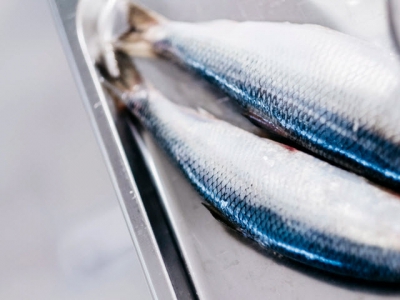Research reveals new ways to raise EPA and DHA levels in both salmon and humans

Diets containing a mixture of plant oil and fish oil can stimulate both salmon and humans to produce their own long chain omega-3 fats, according to new research from Nofima.
Herring oil has a high level of cetoleic acid, which serves as an omega-3 catalyst. Photo © Tommy Ellingsen/Nofima
The long chain omega-3 fatty acids EPA and DHA are important for animal and human health. Not least for salmon, which have a lot of these in their natural diet. However, it is important that this valuable resource is fully utilised.
One way is to stimulate farmed salmon to transform more of the short chain omega-3 alpha-linolenic acid (ALA) that we find in plants, into EPA and DHA. Both salmon and humans have limited ability to make EPA and DHA from ALA.
Four years ago, Nofima scientists discovered that cetoleic acid, which is found extensively in fatty species of fish such as sand eels and herring, serves as an omega-3 catalyst. Cetoleic acid actually stimulates the conversion of the short omega-3 ftty acid ALA that plant oils are rich in, to the long and healthy omega-3 fatty acids EPA and DHA.
Scientists have innovatively mixed a North Atlantic fish oil containing high amounts of cetoleic acid with camelina oil rich in ALA. They have tested the combination of the two oils in feeds for rats, which serve as a model system for human nutrition.
“Our hypothesis is that when camelina oil and fish oil are mixed, the cetoleic acid from the fish oil has lots of ALA to work with in order to form EPA and DHA in the body,” says Astrid Nilsson, senior scientist at Nofima.
In the experiments, where up to 50 percent of camelina oil was mixed with a fish oil, there was an equally high final content of DHA in the blood as there was after the ingestion of pure fish oil.
“This means that when you take the best of both worlds, you can use half as much of the EPA- and DHA-rich fish oil and still end up with a jackpot of DHA levels in the body,” says Nilsson.
However, the mixture ratio between available ALA and cetoleic acid will most likely be important in order to achieve the maximum amounts of EPA and DHA.
The scientists also wish to test such combinations of oils on salmon. Mixing plant oil and fish oil in fish feed is nothing new. A Nofima report from 2019 shows that from 2000 to 2016, feed producers went from not using plant oil in feed to having around 20 percent in feed. However, little is known about whether salmon benefit from an interaction between ALA and cetoleic acid in today’s commercial feed.

Camelina oil contains substances that are good in feed combinations with fish oil. Today, the oil is popular on the health food market. Photo © Jon-Are Berg-Jacobsen/Nofima
Nofima’s senior scientist Tone-Kari Østbye has researched the mechanisms behind cetoleic acid in feeding experiments involving salmon, as well as in salmon liver cells and human cells. The results show that cetoleic acid increases the cells’ capacity to synthesize EPA and DHA from the ALA precursor.
“When we see this in human-cell trials, there is a strong indication that the same will occur in humans too. However, we can’t be certain of this until fish oil with high cetoleic acid levels is compared to fish oil with low cetoleic acid levels in human diets,” says Østbye.
The research has taken place in two projects funded by the Norwegian Seafood Research Fund (FHF) and the Research Council of Norway together with industry partners. Important industrial partners are Norsk matraps and TripleNine Group. The fish oils that have been used in the trials have been obtained from lesser sand eel oil and herring.
The results have great commercial value for the fish oil industry:
“The knowledge gained through the projects will also be of great benefit to the aquaculture industry, in terms of optimal utilisation of marine and vegetable oils, and to better manage omega-3 levels in farmed fish,” says R&D manager Ola Flesland from the fish oil manufacturer TripleNine.
The full paper "The long-chain monounsaturated cetoleic acid improves the efficiency of the n-3 fatty acid metabolic pathway in Atlantic salmon and human HepG2 cells," has been published in the British Journal of Nutrition and can be accessed here.
Có thể bạn quan tâm
 Supplemental β-glucan may mitigate enteritis in farmed trout
Supplemental β-glucan may mitigate enteritis in farmed trout Adding β-glucan to the diets of farmed trout may support weight gain, fish performance and feed efficiency while reducing symptoms of enteritis, say researchers
 Researchers look to new ways to tackle CMS in salmon
Researchers look to new ways to tackle CMS in salmon Experts from the Scottish aquaculture industry, academia & veterinary diagnostics, are aiming to develop a new early warning system for cardiomyopathy syndrome
 Preventing and controlling salmon lice in commercial aquaculture
Preventing and controlling salmon lice in commercial aquaculture A cohort study of commercial salmon farms in Norway explores different prevention and treatment strategies for salmon lice and finds that habituated cleaner